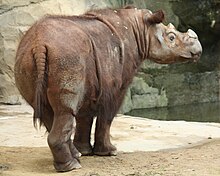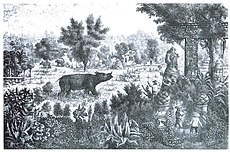蘇門答臘犀
| 蘇門答臘犀 化石時期:
| |
|---|---|

| |
| 2013年印尼蘇門答臘島韋卡巴斯國家公園的蘇門犀保護區內,一頭散放飼養的名為「拉圖」(英文:Ratu)的雌性蘇門犀 | |
| 科學分類 | |
| 界: | 動物界 Animalia |
| 門: | 脊索動物門 Chordata |
| 綱: | 哺乳綱 Mammalia |
| 目: | 奇蹄目 Perissodactyla |
| 科: | 犀科 Rhinocerotidae |
| 屬: | 雙角犀屬 Dicerorhinus |
| 種: | 蘇門答臘犀 D. sumatrensis
|
| 二名法 | |
| Dicerorhinus sumatrensis | |
| 亞種[4] | |

| |
| 野生蘇門犀的分布範圍,紅色部分為當前分布,橙色部分為歷史分布[2][5] | |
| 異名[6] | |
| |
蘇門答臘犀(學名:Dicerorhinus sumatrensis)簡稱蘇門犀,又稱雙角犀或毛犀牛,是一種原產於印度尼西亞、中南半島、南亞次大陸東北部及中國西南部的犀牛[7][8][9],雙角犀屬的唯一現生種。棲息於熱帶雨林和山地苔蘚森林,偶爾出現在森林邊緣和次生林中[2],獨居,取食植物葉片、細枝、幼苗與果實[10]。成體肩高約135公分,體長240–315公分,尾長約50公分,體重800–1000公斤[10],為現存五種犀牛中平均體型最小者。鼻上至前額之間長有兩隻角,前角大而後角小,類似非洲的白犀和黑犀,區別於同域分布的印度犀和爪哇犀。一身紅棕色被毛為其顯著特徵,是世界上最後生存的披毛犀牛。
由於傳統醫學對犀牛角的需求,蘇門犀長期被人類獵殺,同時牠們賴以生存的許多原始森林被改造為人工油棕林,或因大規模伐木、資源開採、道路修建等活動而遭破壞、侵佔[2],致使牠們已在99%以上的歷史分布區域滅絕[11]。自2007年馬來半島的種群最後一次被記錄到以來,僅能確認蘇門犀在印尼蘇門答臘島和婆羅洲北端的馬來西亞沙巴州仍有分布[11],2013年又在婆羅洲東部的印尼東加里曼丹省西庫台縣發現了其足跡,並透過隱藏式相機拍到了活體照片[12][13]。2015年,沙巴的蘇門犀被宣布野外滅絕,僅存一頭雄犀「Tam」與兩頭雌犀「Puntung」和「Iman」,飼養於沙巴的塔賓野生動物保護區內[14]。2016年3月,一頭為捕獵陷阱所傷的雌性幼犀,在東加里曼丹西庫台被捕獲施救[15][2][註 2],進而確認東加里曼丹還有一個小種群存在(此前蘇門犀被認為已在當地滅絕,40年來都未曾發現[13])。2017年5月–2019年11月,馬來西亞的最後三頭蘇門犀「Puntung」「Tam」和「Iman」相繼死亡[18][19][20][21][22][23],至此印尼成為世界上唯一擁有原生蘇門犀的國家。
截至2019年,活體蘇門犀估計已不足80頭,僅剩一些小而零散的種群殘存於蘇門答臘和東加里曼丹。儘管自21世紀以來,先後在美國辛辛那提動物園和印尼韋卡巴斯國家公園蘇門犀保護區實現了人工繁殖,但其前景仍不容樂觀。根據 IUCN 的評估,蘇門犀為極危物種,數量呈下降趨勢,可維持種群繁衍的成熟個體僅有約30頭[2]。
命名與分類
[編輯]
西方學界對蘇門犀的最早記載是在1793年,當時一頭犀牛在蘇門答臘島 Fort Marlborough 地區16公里外的郊野被槍殺。該標本的畫像與文字描述被送到英國自然學家 Joseph Banks 的手裡,他出版了一份關於此標本的文獻資料,不過直到1814年這個物種才被德國學者約翰·菲舍爾·馮瓦爾德海姆(德文:Johann Fischer von Waldheim)正式命名。卡爾·林奈本將所有的犀牛歸入犀牛屬(Rhinoceros ,中文現稱獨角犀屬),所以蘇門犀最初的學名為 Rhinoceros sumatrensis。後來的學家認為蘇門犀的雙角比較特別,並將牠劃為獨立的雙角犀屬(Dicerorhinus)。學名「Dicerorhinus sumatrensis」源自古希臘語 Di(兩個)+cero(角)+rhinus(鼻)+sumatrensis(蘇門答臘的),意即「蘇門答臘的雙鼻角犀」[24][25]。
1793年,歐洲人首次錄製了蘇門答臘犀牛的記錄,當時醫生威廉·貝爾檢查了在蘇門答臘馬爾伯勒堡附近槍殺的一個標本。他做了描述並繪製了圖紙,然後將其發送給當時的皇家學會主席約瑟夫·班克斯(Joseph Banks,1742–1820)。蘇門答臘犀牛作為犀牛的第一個有效的科學描述僅在1814年由德國自然學家 Gotthelf Fischer von Waldheim(1771–1853)提供,當時是莫斯科自然歷史博物館的館長[26]。
現為學界所認可的蘇門犀亞種有三個:
- 西蘇門答臘犀(D. s. sumatrensis),又稱蘇門答臘犀指名亞種、蘇門答臘亞種或西部亞種,分布在蘇門答臘島與馬來半島,是現存數量最多的蘇門犀亞種。馬來半島的種群曾被列為單獨的亞種 D. s. niger,但後來發現牠們與蘇門答臘島的種群十分近似[26]。
- 北蘇門答臘犀(D. s. lasiotis),又稱蘇門答臘犀北方亞種,體型較大,曾廣布於中南半島、印度阿薩姆邦、不丹、孟加拉國、中國華南甚至中原地區[註 3],一般認為在20世紀便已滅絕,但未經證實的報道表明,緬甸北部可能還殘存著一個種群,然而該國的政治混亂阻礙了進一步的調查[7]。
演化
[編輯]犀牛最早出現於早始新世,DNA 的對比表明犀牛與馬在5000萬年前分化[27][28],現存犀牛的祖先在晚始新世的歐亞大陸出現[29]:13[30]。
最早的雙角犀屬化石紀錄出現於2300–1600萬年前的中新世早期。基因研究表明雙角犀在2590±190萬年前就已與其他犀牛分化。現有三種對於蘇門犀與其他現存犀牛的親緣關係的假說:一說蘇門犀與非洲的黑犀與白犀是近親,因為牠們都有兩隻角[27]。其他分類學者認為蘇門犀與印度犀和爪哇犀更接近,因為牠們的分布範圍重疊[27][31]。近期研究則表明兩種非洲犀牛,兩種亞洲獨角犀和蘇門犀各自代表三種自2590萬年前分化的不同世系,而哪一支最先分化目前仍不確定[27][32]。
基於形態特徵,已滅絕的披毛犀(Coelodonta antiquitatis)和斯迪凡犀屬(Stephanorhinus)被認為與蘇門犀密切相關,這一點也得到了分子分析的支持[33]。
形態特徵
[編輯]蘇門犀身材矮壯,四肢粗短,前肢後方及後肢前方連接軀幹處各有一道明顯的褶皺,頸部也有許多褶皺。上唇呈鉤狀,可以捲起[10]。皮膚呈灰褐色,厚10–16毫米。全身覆有粗糙的紅棕色被毛,耳部和尾端有較長的鬃毛,是現存體毛最多的犀牛,幼崽的毛尤為濃密[34][35][36]。
蘇門犀是現存體型最小的犀牛[25],成體肩高約120–145公分,體長約250公分;體重500–800公斤[36],最大紀錄來自動物園飼養的個體,重達2000公斤[35]。兩性都有兩隻深灰色或黑色的角,雄性的角通常比雌性大。前角又稱「鼻角」,長度一般為15–25公分,最長的一件標本達81公分;後角又稱「額角」,通常短於10公分[35][36]。
 |
 |
 |
生活習性
[編輯]蘇門犀為獨居動物,成年雄性的家域(活動範圍)平均為30平方公里,邊緣地帶和其他同類的家域存在廣泛重疊;雌性的家域較小,平均為10–15平方公里。兩性都以刮擦木石、排泄、折彎樹苗的方式來標記家域[10]。
蘇門犀在黎明前和黃昏後覓食,並於夜間活動,白天則待在泥塘或池塘里休息[10]。牠們有相當多的時間都在泥浴中度過,正午時分通常在泥塘內伏臥2–3個小時。一個泥塘會被使用2–12周,當泥塘因乾涸而變小時,牠們會用腳將其刨深。泥浴能幫助牠們降溫並去除皮膚上的寄生蟲,人工飼養蘇門犀容易失敗的原因之一便是缺乏泥浴,進而導致牠們的皮膚發炎、化膿、脫毛直至最終的死亡[37]。
已記錄到蘇門犀會進行季節性的遷徙,在雨季遷徙至海拔較高的地區,在寒涼的旱季遷回低地[34]。雖然看似笨重,但蘇門犀在森林中的行動非常迅捷,奔跑時速達40公里[25];能在陡坡上行動自如,且善於游泳,已發現有個體涉險游入棲息地周邊的海域[10]。牠們需要攝取鹽分,種群圍繞在含鹽的地域生活;在一片含鹽的地域周圍,種群密度可達每平方公里13–14頭[10]。
除人類以外沒有其他的動物獵殺蘇門犀,老虎和野狗可能會捕殺其幼崽。儘管蘇門犀與亞洲象、馬來貘的分布範圍重疊,但未發現牠們之間會爭奪食物和棲息地,亞洲象與蘇門犀甚至會共享一條林間廊道,牠們開闢的廊道會被許多較小的動物(如野豬和鹿)使用[34][38]。
食性
[編輯]蘇門犀以植物嫩葉、嫩芽、細枝、樹苗和水果為食[35],每天的平均進食量達50公斤[34]。糞便樣本顯示其食性很廣,以超過100種植物為食;最常見的食物是樹幹直徑1–6公分的樹苗,牠們通常將這些樹苗推倒,並吃掉上面的樹葉;最常見的食物種類則為番櫻桃屬(Eugenia)植物。
交流
[編輯]| 蘇門犀的叫聲(WAV 文件)[40] | |
|---|---|
蘇門犀是最常發出叫聲的現存犀牛[40],在野外和豢養環境下都觀察到牠們頻繁發聲[36]。最常見的三種聲音包括「咦」「鯨歌」與「尖哨聲」:「咦」是一種長約1秒的尖叫,是最常見的聲音;「鯨歌」類似鯨魚的鳴聲;「尖哨聲」是三種聲音中最響的,能使動物園的鐵欄震動,並能傳播得很遠(亞洲象發出的類似聲音可散播至9.8公里以外,據此推測蘇門犀的尖哨聲也能傳播至相似的距離)。這些聲音的作用尚不清楚,可能與其他有蹄動物一樣,用於警報或傳遞位置、發情信息[40]。蘇門犀會將未吃掉的樹苗扭曲,作為其家域或小徑交叉口的地標[38]。
生長繁殖
[編輯]雌性蘇門犀的性成熟年齡為6–7歲,雄性約為10歲。孕期約477天(15–16個月;數據源自美國辛辛那提動物園的三頭雌犀),每胎一崽,幼犀在16–18個月大時斷奶,並與母親共同生活2–3年;雌犀的生育間隔為3–4年。推測壽命為30–45年,飼養環境下的最長記錄為32年零8個月,來自1900年死於倫敦動物園的一頭雌性北蘇門犀[25][10][35]。
對蘇門犀繁殖行為的了解全部基於人工飼養的個體。牠們交配前會有一段戀愛期,表現為聲音交流增加、尾部上揚、頻繁小便及與異性更多的肉體接觸(例如用口鼻部觸摸異性的頭部與生殖器)。年輕雄性在求愛過程中往往會攻擊雌性,導致雌性受傷甚至死亡[25]。在野外,雌性會逃離過度粗暴的雄性,因而導致種群繁殖率低下[41][42][43]。
發情期長約24小時,並會在21–25天後再度發情。辛辛那提動物園的個體交配時間約為30–50分鐘,在馬來西亞蘇門犀保護中心的個體則較短暫。蘇門犀較長的交配時間與對其他犀牛的觀察,表明其交配季節也應該較長[41]。2001年之前的飼養繁殖都因各種原因而失敗。研究發現蘇門犀的排卵依靠交配催生,並有不穩定的孕酮數量[44],2001年的成功繁殖是因孕酮的補給[45]。
種群現狀
[編輯]此章節需要擴充。 |
蘇門犀現為世界上最接近滅絕的哺乳動物之一,活體數量已不足80頭[46]。與同樣瀕臨滅絕的爪哇犀相比,儘管蘇門犀的數量可能更多,但所受的生存威脅卻更大,因其殘存的種群較為零散,在地理上相互隔絕,而爪哇犀的殘存種群則都集中在爪哇島西端的烏戎庫隆國家公園,同時蘇門犀的數量正在下降,而爪哇犀的數量則較為穩定[5][47]。這兩種犀牛都被列為極危物種,偷獵與棲息地的喪失導致牠們僅存在於人類幾乎無法到達的區域[48][49]。
蘇門犀數量稀少加之所處環境較為密閉,很難被直接捕獲或研究(有研究者在一處鹽田蹲守了七周才遇到蘇門犀),因此未曾像非洲犀牛那樣遭到大規模獵殺,但偷獵依然是對其最大的威脅之一。犀牛角的價格極其昂貴,可達每公斤3萬美元,且價格會隨著數量的減少而提高[29]。印尼當地居民會用犀角做護身符,認為它可預防疾病與中毒。干犀肉則被用作治療腹瀉、麻風與肺結核的傳統藥材。犀牛頭骨還會被浸泡於椰油中長達數周,用以生產治療皮膚病的「犀油」。這些藥材在中醫藥學中使用甚廣[36][7][38]。
| 地區 | 1997年 | 2011年 | 2019年 |
|---|---|---|---|
| 蘇門答臘古農列尤擇國家公園 | 60 | 60–80 | 18–30 |
| 蘇門答臘武吉巴里杉西拉坦國家公園 | 22 | 50–70 | 4–15 |
| 蘇門答臘韋卡巴斯國家公園 | 16 | 27–33 | 15–30 |
| 蘇門答臘葛林芝塞布拉國家公園 | 28 | 0 | 0 |
| 印尼其他區域 | 25 | 10–15 | 3? |
| 馬來半島大漢山國家公園 | 44 | 21–34 | 0 |
| 馬來半島柏隆皇家公園 | 10 | 12–13 | 0 |
| 馬來半島興樓雲冰國家公園 | 9 | 1–2 | 0 |
| 沙巴丹濃谷自然保護區 | 11 | 13–15 | 0 |
| 沙巴塔賓野生動物保護區 | 20 | 15 | 0 |
| 大馬其他區域 | 75 | 7 | 0 |
| 總計 | 320 | 216–284 | 40–78 |
相關圖像
[編輯]-
倫敦動物園在1886年引進的雄性北蘇門犀「傑克遜」(英文:Jackson)[53],後於1910年死亡,是該園最後一頭蘇門犀。照片攝於1903–1905年間。
-
2008年,韋卡巴斯國家公園蘇門犀保護區,人工放養的雌性蘇門犀「羅莎」(英文:Rosa)。
-
2012年6月,韋卡巴斯國家公園蘇門犀保護區,人工放養的雌犀「拉圖」(英文:Ratu)產下一頭雄性幼崽,是東半球第一頭、世界第五頭人工繁育的蘇門犀,後取名為「安達圖」(英文:Andatu)。
-
2012年6月,韋卡巴斯國家公園蘇門犀保護區,「拉圖」和牠4天大的兒子「安達圖」。
-
2015年4月,韋卡巴斯國家公園蘇門犀保護區,約3歲大的「安達圖」正在進食。(點擊播放)
備註
[編輯]參考文獻
[編輯]- ^ Deng, T.; Wang, X.; Fortelius, M.; Li, Q.; Wang, Y.; Tseng, Z.J.; Takeuchi, G.T.; Saylor, J.E.; Säilä, L.K.; Xie, G. Out of Tibet: Pliocene woolly rhino suggests high-plateau origin of Ice Age megaherbivores. Science. 2011, 333 (6047): 1285–1288. Bibcode:2011Sci...333.1285D. PMID 21885780. S2CID 8913866. doi:10.1126/science.1206594.
- ^ 2.0 2.1 2.2 2.3 2.4 2.5 Ellis, S. & Talukdar, B. Dicerorhinus sumatrensis. The IUCN Red List of Threatened Species. 2020: e.T6553A18493355. doi:10.2305/IUCN.UK.2020-2.RLTS.T6553A18493355.en
 .
.
- ^ Appendices | CITES. cites.org. (原始內容存檔於2017-12-05).
- ^ Dicerorhinus sumatrensis. ITIS. [2021-03-19].
- ^ 5.0 5.1 Sumatran Rhino. WWF. (原始內容存檔於2019-06-12).
- ^ Sumatran Rhino Scientific names. Rhino Resource Center. (原始內容存檔於2021-05-21).
- ^ 7.0 7.1 7.2 Foose, Thomas J.; van Strien, Nico. (編). Asian Rhinos – Status Survey and Conservation Action Plan. Gland, Switzerland, and Cambridge, UK: IUCN/SSC Asian Rhino Specialist Group. 1997. ISBN 2-8317-0336-0.
- ^ Chapman, Jan. The Art of Rhinoceros Horn Carving in China. London: Christie's Books. 1999: 27. ISBN 0-903432-57-9.
- ^ Schafer, Edward H. The Golden Peaches of Samarkand: A study of T'ang Exotics. Berkeley and Los Angeles: University of California Press. 1963: 83.
- ^ 10.0 10.1 10.2 10.3 10.4 10.5 10.6 10.7 Huffman, Brent. Sumatran rhinoceros. Ultimate Ungulate. (原始內容存檔於2020-11-27).
- ^ 11.0 11.1 Havmøller, Rasmus Gren; Payne, Junaidi; Ramono, Widodo; Ellis, Susie; Yoganand, K.; Long, Barney; Dinerstein, Eric; et al. Will current conservation responses save the Critically Endangered Sumatran rhinoceros Dicerorhinus sumatrensis?. Oryx. 2015, 50 (2): 355–359. doi:10.1017/S0030605315000472
 .
.
- ^ Satriastanti, Fidelis E. 15 Bornean rhinos discovered in Kalimantan?. Mongabay. 2016-03-14. (原始內容存檔於2020-11-08).
- ^ 13.0 13.1 Howard, Brian Clark. Rare Sumatran Rhino Found for First Time in 40 Years. nationalgeographic.com. 2016-03-25 [2022-01-20]. (原始內容存檔於2022-01-09).
- ^ Hance, Jeremy. Officials: Sumatran rhino is extinct in the wild in Sabah. Mongabay. 2015-04-23. (原始內容存檔於2015-12-07).
- ^ Rare Sumatran rhino sighted in Indonesian Borneo. Fox News. 2016-03-23. (原始內容存檔於2020-03-16).
- ^ Howard, Brian Clark. Rare Rhino Dies Days After Her Rediscovery. nationalgeographic.com. 2016-04-06 [2021-03-10].
- ^ Sadjudin, Haerudin R. The long journey to saving the Sumatran rhino, via Borneo (commentary). Mongabay. 2018-12-20. (原始內容存檔於2020-11-08).
- ^ Nunez, Christina. Saved Once by Social Media, Rare Rhino’s Luck Runs Out. nationalgeographic.com. 2017-06-04 [2021-03-10].
- ^ 【救救牠們】大馬最後雄性蘇門答臘犀牛死亡 全球僅剩不足80隻. 蘋果日報 (香港). 2019-05-27 [2021-03-10]. (原始內容存檔於2021-06-21).(繁體中文)
- ^ Lee, Stephanie. Malaysia's last Sumatran rhino Iman dies, species now extinct in the country. The Star. 2019-11-23. (原始內容存檔於2021-03-27).
- ^ Malaysia's last known Sumatran rhino dies. BBC News. 2019-11-23. (原始內容存檔於2021-03-09).
- ^ Bellware, Kim. Sumatran rhinos are extinct in their native Malaysia after last living female dies. The Washington Post. 2019-11-24. (原始內容存檔於2020-02-07).
- ^ Bittel, Jason. Last Sumatran rhino in Malaysia dies. nationalgeographic.com. 2019-11-24. (原始內容存檔於2021-04-24).
- ^ Liddell, Henry G.; Scott, Robert. Greek-English Lexicon (Abridged ed). Oxford: Oxford University Press. 1980. ISBN 0-19-910207-4.
- ^ 25.0 25.1 25.2 25.3 25.4 Sumatran Rhino - Dicerorhinus sumatrensis. Rhino Resource Center. (原始內容存檔於2009-02-18).
- ^ 26.0 26.1 Rookmaaker, L.C. The taxonomic history of the recent forms of Sumatran Rhinoceros (Dicerorhinus sumatrensis). Journal of the Malayan Branch of the Royal Asiatic Society. 1984, 57 (1): 12–25. JSTOR 41492969. (原始內容存檔於2020-10-06).
- ^ 27.0 27.1 27.2 27.3 Tougard, C.; Delefosse, T.; Hoenni, C.; Montgelard, C. Phylogenetic relationships of the five extant rhinoceros species (Rhinocerotidae, Perissodactyla) based on mitochondrial cytochrome b and 12s rRNA genes. Molecular Phylogenetics and Evolution. 2001, 19 (1): 34–44. PMID 11286489. doi:10.1006/mpev.2000.0903.
- ^ Xu, Xiufeng; Janke, Axel; Arnason, Ulfur. The Complete Mitochondrial DNA Sequence of the Greater Indian Rhinoceros, Rhinoceros unicornis, and the Phylogenetic Relationship Among Carnivora, Perissodactyla, and Artiodactyla (+ Cetacea). Molecular Biology and Evolution. 1996, 13 (9): 1167–1173 [2022-01-21]. PMID 8896369. doi:10.1093/oxfordjournals.molbev.a025681
 . (原始內容存檔於2022-01-21).
. (原始內容存檔於2022-01-21).
- ^ 29.0 29.1 Dinerstein, Eric. The Return of the Unicorns; The Natural History and Conservation of the Greater One-Horned Rhinoceros. New York: Columbia University Press. 2003. ISBN 0-231-08450-1.
- ^ Lacombat, Frédéric. The evolution of the rhinoceros. Fulconis, R. (編). Save the rhinos: EAZA Rhino Campaign 2005/6 (PDF). London: EAZA. 2005: 46–49 [2022-01-21]. (原始內容存檔 (PDF)於2022-01-21).
- ^ Groves, C.P. Phylogeny of the living species of rhinoceros (PDF). Zeitschrift für Zoologische Systematik und Evolutionsforschung. 1983, 21 (4): 293–313 [2022-01-21]. doi:10.1111/j.1439-0469.1983.tb00297.x. (原始內容存檔 (PDF)於2022-01-21).
- ^ Cerdeño, Esperanza. Cladistic Analysis of the Family Rhinocerotidae (Perissodactyla). American Museum Novitates (American Museum of Natural History). 1995, (3143): 1–25. hdl:2246/3566
 .
.
- ^ Orlando, Ludovic; Leonard, Jennifer A.; Thenot, Aurélie; Laudet, Vincent; Guerin, Claude; Hänni, Catherine. Ancient DNA analysis reveals woolly rhino evolutionary relationships (PDF). Molecular Phylogenetics and Evolution. 2003, 28 (2): 485–499. PMID 12927133. doi:10.1016/S1055-7903(03)00023-X. (原始內容存檔 (PDF)於2016-03-04).
- ^ 34.0 34.1 34.2 34.3 van Strien, Nico. Sumatran rhinoceros. Fulconis, R. (編). Save the rhinos: EAZA Rhino Campaign 2005/6 (PDF). London: EAZA. 2005: 70–74 [2022-01-21]. (原始內容存檔 (PDF)於2022-01-21).
- ^ 35.0 35.1 35.2 35.3 35.4 Groves, C.P.; Kurt, F. Dicerorhinus sumatrensis (PDF). Mammalian Species. 1972, (21): 1–6 [2021-03-11]. JSTOR 3503818. doi:10.2307/3503818. (原始內容 (PDF)存檔於2012-11-01).
- ^ 36.0 36.1 36.2 36.3 36.4 van Strien, N.J. Dicerorhinus sumatrensis (Fischer), the Sumatran or two-horned rhinoceros: a study of literature. Mededelingen Landbouwhogeschool Wageningen. 1974, 74 (16): 1–82. (原始內容存檔於2020-02-03).
- ^ Julia Ng, S.C.; Zainal-Zahari, Z.; Nordin, Adam. Wallows and Wallow Utilization of the Sumatran Rhinoceros (Dicerorhinus Sumatrensis) in a Natural Enclosure in Sungai Dusun Wildlife Reserve, Selangor, Malaysia (PDF). Journal of Wildlife and Parks. 2001, 19: 7–12 [2022-01-21]. (原始內容存檔 (PDF)於2022-01-21).
- ^ 38.0 38.1 38.2 38.3 Borner, Markus. A field study of the Sumatran rhinoceros Dicerorhinus sumatrensis Fischer, 1814: Ecology and behaviour conservation situation in Sumatra. Zurich: Juris Druck & Verlag. 1979. ISBN 3-260-04600-3.
- ^ Lee, Yook Heng; Stuebing, Robert B.; Ahmad, Abdul Hamid. The Mineral Content of Food Plants of the Sumatran Rhino (Dicerorhinus sumatrensis) in Danum Valley, Sabah, Malaysia (PDF). Biotropica. 1993, 3 (5): 352–355. JSTOR 2388795. doi:10.2307/2388795. (原始內容存檔 (PDF)於2016-03-04).
- ^ 40.0 40.1 40.2 von Muggenthaler, Elizabeth; Reinhart, Paul; Limpany, Brad; Craft, R. Barton. Songlike vocalizations from the Sumatran Rhinoceros (Dicerorhinus sumatrensis) (PDF). Acoustics Research Letters Online. 2003, 4 (3): 83 [2022-01-21]. doi:10.1121/1.1588271
 . (原始內容存檔 (PDF)於2021-11-23).
. (原始內容存檔 (PDF)於2021-11-23).
- ^ 41.0 41.1 Zainal-Zahari, Z.; Rosnina, Y.; Wahid, H.; Yap, K.C.; Jainudeen, M.R. Reproductive behaviour of captive Sumatran rhinoceros (Dicerorhinus sumatrensis) (PDF). Animal Reproduction Science. 2005, 85 (3–4): 327–335 [2022-01-21]. PMID 15581515. doi:10.1016/j.anireprosci.2004.04.041. (原始內容存檔 (PDF)於2022-01-21).
- ^ Zainal-Zahari, Z.; Rosnina, Y.; Wahid, H.; Jainudeen, M.R. Gross Anatomy and Ultrasonographic Images of the Reproductive System of the Sumatran Rhinoceros (Dicerorhinus sumatrensis) (PDF). Anatomia, Histologia, Embryologia. 2002, 31 (6): 350–354 [2022-01-21]. PMID 12693754. S2CID 19009013. doi:10.1046/j.1439-0264.2002.00416.x. (原始內容 (PDF)存檔於2018-01-19).
- ^ Roth, T.L.; Radcliffem, R.W.; van Strien, N.J. New hope for Sumatran rhino conservation (abridged from Communique) (PDF). International Zoo News (abridged from Communiqué). 2006, 53 (6): 352–353 [2022-01-21]. (原始內容存檔 (PDF)於2021-12-27).
- ^ Roth, T.L.; O'Brien, J.K.; McRae, M.A.; Bellem, A.C.; Romo, S.J.; Kroll, J.L.; Brown, J.L. Ultrasound and endocrine evaluation of the ovarian cycle and early pregnancy in the Sumatran rhinoceros, Dicerorhinus sumatrensis (PDF). Reproduction. 2001, 121 (1): 139–149 [2022-01-21]. PMID 11226037. doi:10.1530/rep.0.1210139
 . hdl:10088/324
. hdl:10088/324  . (原始內容存檔 (PDF)於2022-01-21).
. (原始內容存檔 (PDF)於2022-01-21).
- ^ Roth, T.L. Breeding the Sumatran rhinoceros (Dicerorhinus sumatrensis) in captivity: behavioral challenges, hormonal solutions (PDF). Hormones and Behavior. 2003, 44: 31 [2022-01-21]. S2CID 54311703. doi:10.1016/S0018-506X(03)00068-0. (原始內容存檔 (PDF)於2021-07-09).
- ^ Williams, David; Ko, Stella. The last Sumatran rhino in Malaysia has died and there are less than 80 left in the world. CNN. 2019-11-24. (原始內容存檔於2021-01-23).
- ^ Ellis, S. & Talukdar, B. Rhinoceros sondaicus. The IUCN Red List of Threatened Species. 2020: e.T19495A18493900. doi:10.2305/IUCN.UK.2020-2.RLTS.T19495A18493900.en
 .
.
- ^ Rabinowitz, Alan. Helping a Species Go Extinct: The Sumatran Rhino in Borneo (PDF). Conservation Biology. 1995, 9 (3): 482–488 [2022-01-21]. doi:10.1046/j.1523-1739.1995.09030482.x. (原始內容 (PDF)存檔於2014-08-10).
- ^ van Strien, Nico J. Conservation Programs for Sumatran and Javan Rhino in Indonesia and Malaysia. Proceedings of the International Elephant and Rhino Research Symposium, Vienna, June 7–11, 2001 (Scientific Progress Reports). 2001.
- ^ Ahmad Zafir, Abdul Wahab; Payne, Junaidi; Mohamed, Azlan; Lau, Ching Fong; Sharma, Dionysius Shankar Kumar; Alfred, Raymond; Williams, Amirtharaj Christy; Nathan, Senthival; Ramono, Widodo S.; Clements, Gopalasamy Reuben. Now or never: what will it take to save the Sumatran rhinoceros Dicerorhinus sumatrensis from extinction?. Oryx. 2011, 45 (2): 225–233. doi:10.1017/S0030605310000864.
- ^ Emslie, Richard H.; Milliken, Tom; Talukdar, Bibhab; Burgess, Gayle; Adcock, Karyn; Balfour, David; Knight, Michael H. African and Asian rhinoceroses - status, conservation and trade. A report from the IUCN Species Survical Commission (IUCN/SSC) African and Asian Rhino Specialist Groups and TRAFFIC to the CITES Secretariat pursuant to Resolution Conf. 9.14 (Rev. CoP17). Report to CITES 17th meeting, CoP18 Doc. 83.1 Annex 2. Colombo: 1–38. 2019-06. (原始內容存檔於2021-05-21).
- ^ Rhino Images: London 1872. Rhino Resource Center. (原始內容存檔於2016-03-04).
- ^ Rookmaaker, L.C. The rhinoceros in captivity: a list of 2439 rhinoceroses kept from Roman times to 1994. Kugler Publications. 1998: 125. ISBN 978-90-5103-134-8. (原始內容存檔於2020-02-14).
- ^ Maxwell, Emily. From Cincinnati to Sumatra: Taking a rhino across the world in a cargo plane. WCPO.com. 2015-11-22. (原始內容存檔於2020-11-08).








![「貝格姆」的畫像,來自1876年英國動物學家菲利普·斯克萊特的相關研究著作[52]。](http://upload.wikimedia.org/wikipedia/commons/thumb/b/b6/Sumatran_Rhino_London-1872.jpg/230px-Sumatran_Rhino_London-1872.jpg)
![倫敦動物園在1886年引進的雄性北蘇門犀「傑克遜」(英文:Jackson)[53],後於1910年死亡,是該園最後一頭蘇門犀。照片攝於1903–1905年間。](http://upload.wikimedia.org/wikipedia/commons/thumb/9/9b/Jackson_rhino.jpg/218px-Jackson_rhino.jpg)

![2008年7月,辛辛那提動物園,「埃米」和14個月大的「哈拉潘」。「哈拉潘」是「埃米」的第三個幼崽,使「埃米」創造了飼養條件下蘇門犀的最高生育紀錄,同時也是西半球飼養的最後一頭蘇門犀,於2015年11月被轉送至印尼韋卡巴斯國家公園的蘇門犀保護區參與人工繁殖[54]。](http://upload.wikimedia.org/wikipedia/commons/thumb/3/33/Sumatran_Rhino_2.jpg/227px-Sumatran_Rhino_2.jpg)




